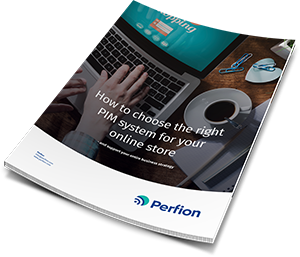
If you’re making the switch to a new eCommerce platform, there’s a lot you need to consider. Have you chosen the right hosting provider? Are you using the right payment system? Is the customer journey as intuitive as it can be?
You need to consider this question too:
How can you easily migrate all your product data to the new eCommerce platform?
In this article, we will look at whether a Product Information Management (PIM) system is the ideal choice for handling product data for your new eCommerce platform and how it can potentially help you grow.
You will find out if PIM eCommerce integration can create value for you.
What is PIM in eCommerce, and how can it help your business?
A Product Information Management solution is a centralised system that manages all your product data in one place. From here, this data is seamlessly pushed to your webshop, while still stored in the PIM system. This makes it easier to add new products and update existing ones, as well as manage the content across all your marketing platforms.
So how can PIM help with your online shop? PIM makes eCommerce data management simpler than ever before. With a click of a button, you can make sure your eCommerce platform – and all other sales and marketing platforms – show the correct dimensions, products and prices.
|
How to choose the right |
PIM vs no PIM when it comes to your new eCommerce platform
At this point, you’re probably wondering if PIM is the right choice for your new online store.
It may be that you are currently using an Excel Spreadsheet or Google Sheet to manage all your product information, and you want to see if it is worth investing in a brand-new system. It may even be the case that the only place you’re hosting all your product data is on your existing website.
Here are just some of the reasons why PIM can give you the advantage when it comes to moving across to a new eCommerce platform.
You can launch much more quickly
Migrating your existing content to a new eCommerce platform is not a simple task, especially if your products have complex product information and/or a lot of variants and specifications. The good news is that PIM can make moving to a new eCommerce platform a lot more straightforward.
With PIM, you can export data from your existing eCommerce solution, review it and import it straight into your new platform. No need to spend hours manually moving your data from one site to another or cross-checking spreadsheets.
Looking to redesign your product data sheets to match your new site design? PIM makes this easy too. One push of a button and your new templates will be populated with all your existing product data.
Launching a foreign-language eCommerce site? In the PIM system, you can store all your product data in various languages, multiple currencies and different measurements and push data directly to your new eCommerce site. Product information management makes localising your brand easier and more accurate than ever before.
PIM means that your staff can focus on making sales and growing your business, rather than copying and pasting content.
There is less risk of inaccuracies
A UK-based eCommerce store once accidentally offered a £1,099 television for £199. Customers took the opportunity to snap up a bargain, but then became angry when the business decided not to honour the error.
PIM can reduce the risk of incidents like this happening when you’re moving content from one site to another. As all information is stored and updated in one central database, it is easier to review and amend information before it goes live.
Plus, as the information doesn’t have to be manually entered directly into the eCommerce website, there is less chance of human error.
Your data is yours and yours alone
Business continuity is essential to companies large and small. If your new hosting provider goes out of business or your eCommerce site falls foul of a ransomware attack, there is a risk that your product information will be lost forever.
With PIM, even if your website disappears, your product data is safe. As your information is held independently of your other platforms, you can bounce back quickly.
In conclusion: Is PIM right for your eCommerce data management?
If you’re keen to switch eCommerce platforms but are concerned about porting your product data from one system to another, PIM is definitely something you should consider.
PIM will save time and mean your team can focus on promoting your brand-new eCommerce store to customers.
Of course, if you only have a small eCommerce platform and a handful of products, it might be that you’re happy to stick with your existing system of spreadsheets and documents for the time being. However, as you scale and offer a wider product range, PIM should become a welcome addition to your business.
If you are looking to implement PIM, we recommend either doing so before you switch to a new eCommerce platform, or at the same time. By introducing PIM before you launch, you save replicating data and can launch your online store much sooner.
If you’d like to know more about how PIM and eCommerce go together, get in touch with us today.
How to choose the right PIM system for your online store – Download the guide
 There’s a lot to consider when making a move to a new eCommerce platform.
There’s a lot to consider when making a move to a new eCommerce platform.
In this guide, we will take you through the five steps to selecting the right Product Information Management solution for your online store. What should you emphasise, and what pitfalls do you need to avoid?
